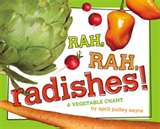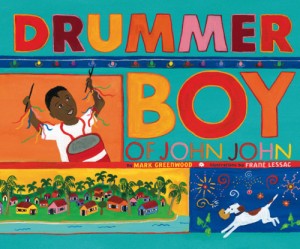“Rah, Rah, Radishes” and Go, STEM!
 Happy May, everyone! I had the pleasure of speaking at an early education conference where our theme was literacy and science. I brought stacks of books that tie into STEM (Science, Technology, Engineering, Mathematics) or STEAM (add Art) to share. Rather than just lecture all day, I led a session of “speed-dating” books: we’d spend a few minutes skimming a book and brainstorming ways to use it with students, share our ideas with the group, and pass the book along. This way, we had time to get our hands on over a dozen books and walk away with practical classroom applications. I was so inspired by the fantastic ideas the teachers generated! Here are a few ideas we came up with after reading Rah,Rah, Radishes! A Vegetable Chant by April Pulley Sayre:
Happy May, everyone! I had the pleasure of speaking at an early education conference where our theme was literacy and science. I brought stacks of books that tie into STEM (Science, Technology, Engineering, Mathematics) or STEAM (add Art) to share. Rather than just lecture all day, I led a session of “speed-dating” books: we’d spend a few minutes skimming a book and brainstorming ways to use it with students, share our ideas with the group, and pass the book along. This way, we had time to get our hands on over a dozen books and walk away with practical classroom applications. I was so inspired by the fantastic ideas the teachers generated! Here are a few ideas we came up with after reading Rah,Rah, Radishes! A Vegetable Chant by April Pulley Sayre:
Bring in vegetables found in the book. Sort the vegetables by color and by size.
Classify and sort vegetables by the parts we eat: root vegetables, leaves, etc. Read Tops and Bottoms by Janet Stevens as a tie-in text and talk about which vegetables would be “tops” or “bottoms” according to Hare.
Predict which vegetables will sink or float. Test predictions in a tub of water. Wash the vegetables and talk about textures.
Use the vegetables to make prints.
Compare and contrast with fruits.
Weigh and measure the vegetables. Use a vegetable as a measuring tool.
Take photos of vegetables and label them. Reread the book and have students hold up the corresponding photos.
Make a chart or a Venn diagram with the terms “raw” and “cooked”. Try some vegetables both ways and chart our preferences.
See what other vegetables besides potatoes can be delicious mashed (great for little ones to do the mashing!)
Bring in potatoes with “eyes” sprouting and bring in vegetable seeds. Compare seeds and sprouts, then plant!
Make an edible collage with vegetables.
Practice patterning skills like ABAB, etc. with bite-size veggies and eat when done.
Plan a field trip to a farmer’s market or invite a farmer to come to the classroom for more vegetable experiences.
If you’re interested in the list of science books I shared, please email me at kristenremenar AT gmail DOT com. If you like Rah, Rah, Radishes! A Vegetable Chant, be sure to check out Go, Go, Grapes! A Fruit Chant and Let’s Go Nuts! Seeds We Eat also by April Pulley Sayre. Hooray for early science!
Read MoreDrummer Boy of John John
 Maybe it’s the vibrant art or maybe it’s the tropical setting of Trinidad, but on this snowy March day, I am in love with Drummer Boy of John John by Mark Greenwood with illustrations by Frane Lessac. Knowing that it’s a biography (so it hits the Common Core standard of Range of Reading) that incorporates music and art makes me love it even more.
Maybe it’s the vibrant art or maybe it’s the tropical setting of Trinidad, but on this snowy March day, I am in love with Drummer Boy of John John by Mark Greenwood with illustrations by Frane Lessac. Knowing that it’s a biography (so it hits the Common Core standard of Range of Reading) that incorporates music and art makes me love it even more.
It’s almost time for Carnival and everyone in Winston’s town is getting ready to celebrate with calypso music. Winston wishes he were in a band, because the best band in the parade will get free rotis from the Roti King. (Is your Craft and Structure Common Core Standard alarm ringing? Lots of interesting word choices in this book!) But Winston has no gourds full of seeds that go “shoush-shap/ shukka-shac” and no bamboo to pound on the ground with a “click clack/ rappa-tap” (Check Print Concepts off on your Common Core score card). When Winston throws his mango pit into the junkyard, he hears a “pong ping pang” as the pit hits old metal. Winston makes his own instrument from the dented metal containers – the first steel drum. Winston’s friends hear this music and form a junkyard band. They paint pots, pans, tins, and cans rainbow colors and experiment with the dents and bumps in the metal to make different pitches. Winston’s band is crowned the best band in the Carnival parade, so they all feast on rotis and mango lemonade.
This book has so many tie-ins for art, music, and social studies. (I wish I’d found it a month ago, so I could’ve used it for Carnival/Mardi Gras, but it’s a fun lesson any time of year.) Students can use recycled cans, jars, bottles and containers to make their own instruments. Paint them in the tropical rainbow colors Lessac used in her art. Play a clip of steel drum music for students (you can get cd’s from your local library or use this Youtube clip: Steel Drums in Trinidad and Tobago. Bring in mangos for students to taste after they try dancing under the limbo pole like the Roti King does. Use your recycled instruments to play a “listen and repeat” rhythm game to build listening skills. Winston Simon began with junk from the junkyard and ended up touring London and Paris with the Trinidad All Stars Percussion Orchestra. Who knows where tin cans and this inspirational book might take your students?
For more information about the author, visit: markgreenwood.com.au.
For more information about the illustrator, visit: franelessac.com
Read More
Planting the Wild Garden
 Everywhere in my yard, plants are growing, many of which I didn’t plant (some call them weeds, I call them uninvited green guests.) How do all those plants in the meadows, by the creek beds, in fields, and by the sides of roads get there? In Planting the Wild Garden written by Kathryn O. Galbraith and gorgeously illustrated by my friend Wendy Anderson Halperin, we learn that we helped those plants: “wind and water. Birds and animals. Plants and people. All of us. Together.”
Everywhere in my yard, plants are growing, many of which I didn’t plant (some call them weeds, I call them uninvited green guests.) How do all those plants in the meadows, by the creek beds, in fields, and by the sides of roads get there? In Planting the Wild Garden written by Kathryn O. Galbraith and gorgeously illustrated by my friend Wendy Anderson Halperin, we learn that we helped those plants: “wind and water. Birds and animals. Plants and people. All of us. Together.”
I love Galbraith’s easy, poetic style for nonfiction. This book doesn’t read like an old science text book, although it is bursting with information. Scotch broom seeds pop out like popcorn in the heat, cockleburs are transplanted when they catch on the fur of a fox, and dandelion seeds are blown to new places by a child. Each page is lushly and accurately illustrated by Halperin, whose award-winning project drawingchildrenintoreading.com is worth investigating if you are an educator or parent of budding readers. After reading this book aloud, give students colored pencils and paper for them to draw the seed transportation method they find most interesting. Read the book aloud twice as children draw, rereading pages students want to hear. Students can practice and demonstrate their listening comprehension through their art. Encourage them to use labels and descriptions to explain their art, and to use onomatopoeia like Galbraith did to build writing skills. Whether this is part of a science unit on plants, a celebration of Earth Day, or a lesson to build listening comprehension, Planting the Wild Garden will plant a love of nature in young learners.
For more inspiration, please visit Kathryn Galbraith’s website: kathrynogalbraith.com and Wendy Anderson Halperin’s website: wendyhalperin.com.
Read MoreThe Piggy in the Puddle
 “See the piggy,
“See the piggy,
see the puddle,
see the muddy little puddle.
See the piggy in the middle
of the muddy little puddle.”
This classic tongue-twisting pig tale, The Piggy in the Puddle, by Charlotte Pomerantz and James Marshall is almost 40 years old, and it is still pure fun to read aloud. The muddy little piggy in the middle of the puddle is told by her family that she must come out of the “squishy-squashy”, “mooshy-squooshy”, “oofy-poofy” mud. Her reply? “Nope!” So what’s a pig to do but join her? Soon the whole family, “big and little”, are “in the very merry middle.”
After you’ve read this book through once just for fun, see if your listeners can keep a simple beat for you as you read it aloud again – just make sure the beat isn’t too fast or you’ll end up tongue-tied! You can use this book with preschoolers through third graders to talk about sounds. Little ones can focus on beginning sounds of P and M, older ones can sort words with short i or short u sounds, or look for “double letters”. For a super-simple craft (because that’s how I roll), I die-cut pigs for kids to glue to construction paper, and then, using just one fingertip (so we wouldn’t end up muddy like the pigs) we dabbed brown paint on our paper to make mud puddles and muddy piggies. Good, clean(ish) fun!
For more information, visit charlottepomerantz.com.
Read More






